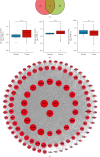The Mechanism of Xiaoyao San in the Treatment of Ovarian Cancer by Network Pharmacology and the Effect of Stigmasterol on the PI3K/Akt Pathway
- PMID: 34306252
- PMCID: PMC8263223
- DOI: 10.1155/2021/4304507
The Mechanism of Xiaoyao San in the Treatment of Ovarian Cancer by Network Pharmacology and the Effect of Stigmasterol on the PI3K/Akt Pathway
Retraction in
-
Retracted: The Mechanism of Xiaoyao San in the Treatment of Ovarian Cancer by Network Pharmacology and the Effect of Stigmasterol on the PI3K/Akt Pathway.Dis Markers. 2023 Jul 12;2023:9791279. doi: 10.1155/2023/9791279. eCollection 2023. Dis Markers. 2023. PMID: 37476639 Free PMC article.
Abstract
Purpose: This study was aimed at exploring the regulatory mechanism of Xiaoyao San (XYS) and its main compound, Stigmasterol, in the biological network and signaling pathway of ovarian cancer (OC) through network pharmacology-based analyses and experimental validation.
Methods: The active compounds and targets of XYS were studied by the Traditional Chinese Medicine Systems Pharmacology Database and Analysis Platform (TCMSP). The GeneCards and OMIM databases were used to screen common targets of XYS in the treatment of OC. Combined with the STRING database and Cytoscape 3.6.0, the core compounds and targets of XYS were obtained. GO and KEGG pathway enrichment analyses of core target genes were carried out by using the Metascape and DAVID databases. Molecular docking has been achieved by using the AutoDock Vina program to discuss the interaction of the core targets and compounds of XYS in the treatment of OC. The effect of Stigmasterol on proliferation and migration were assessed by CCK8 and wound healing assay. Western blot and qRT-PCR were used to analyze the protein and mRNA expressions of PI3K, Akt, and PTEN after treatment of Stigmasterol.
Results: A total of 113 common targets of XYS for the treatment of OC were obtained from 975 targets related to OC and 239 targets of XYS's effect. The main compounds of XYS include Quercetin, Naringenin, Isorhamnetin, and Stigmasterol, which mainly regulate the targets such as TP53, Akt1, and MYC and PI3K/Akt, p53, and cell cycle signal pathways. At the same time, molecular docking showed that Stigmasterol and Akt1 had good docking conformation. Stigmasterol inhibited OC cell proliferation and migration in vitro and reduced the protein and mRNA expressions of the PI3K/Akt signaling pathway.
Conclusion: Stigmasterol as the one of the main compounds of XYS suppresses OC cell activities through the PI3K-Akt signaling pathway.
Copyright © 2021 Meng Li et al.
Conflict of interest statement
The authors declare that they have no competing interests.
Figures



References
Publication types
MeSH terms
Substances
LinkOut - more resources
Full Text Sources
Medical
Research Materials
Miscellaneous

